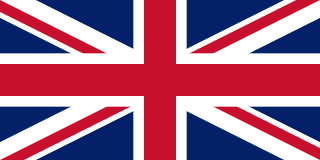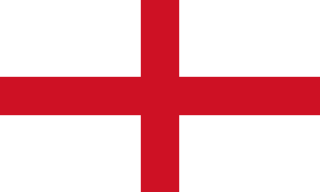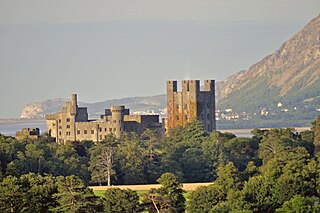Pennant may refer to:
Pennant may refer to:

The Union Jack or Union Flag is the de facto national flag of the United Kingdom. The Union Flag was also used as the official flag of several British colonies and dominions before they adopted their own national flags. The flag continues to have official status in Canada, by parliamentary resolution, where it is known as the Royal Union Flag.
Flag terminology is the nomenclature, or system of terms, used in vexillology, the study of flags, to describe precisely the parts, patterns, and other attributes of flags and their display.

The flag of England is the national flag of England, a constituent country of the United Kingdom. It is derived from Saint George's Cross. The association of the red cross as an emblem of England can be traced back to the Late Middle Ages when it was gradually, increasingly, used alongside the Royal Banner. It became the only saint's flag permitted to be flown in public as part of the English Reformation and at a similar time became the pre-eminent maritime flag referred to as a white ensign. It was used as a component in the design of the Union Jack in 1606.

In British maritime law and custom, an ensign is the identifying flag flown to designate a British ship, either military or civilian. Such flags display the United Kingdom Union Flag in the canton, with either a red, white or blue field, dependent on whether the vessel is civilian, naval, or in a special category. These are known as the red, white, and blue ensigns respectively.

A maritime flag is a flag designated for use on ships, boats, and other watercraft. Naval flags are considered important at sea and the rules and regulations for the flying of flags are strictly enforced. The flag flown is related to the country of registration: so much so that the word "flag" is often used symbolically as a metonym for "country of registration".

The White Ensign, at one time called the St George's Ensign because of the simultaneous existence of a crossless version of the flag, is an ensign worn on British Royal Navy ships and shore establishments. It consists of a red St George's Cross on a white field, identical to the flag of England except with the Union Flag in the upper canton.

The commissioning pennant is a pennant flown from the masthead of a warship. The history of flying a commissioning pennant dates back to the days of chivalry with their trail pendants being flown from the mastheads of ships they commanded. Today, the commissioning pennants are hoisted on the day of commissioning and not struck until they are decommissioned. Some navies have a custom of flying a "paying off" or "decommissioning pennant," the length of which often reflects the length of service of the warship.

A pennon, also known as a pennant or pendant, is a long narrow flag which is larger at the hoist than at the fly, ie., the flag starts to narrow down as it moves away from the flagpole, when viewed from left to right. It can have several shapes, such as triangular, tapering or triangular swallowtail, etc. In maritime use, pennants are to be hung from the main truck.

A French ensign is the flag flown at sea to identify a vessel as French. Several such ensigns have existed over the years as well as terrestrial flags based on the ensign motif.

George Sholto Gordon Douglas-Pennant, 2nd Baron Penrhyn, was a landowner who played a prominent part in the Welsh slate industry as the owner of the Penrhyn Quarry in North Wales.

The Penrhyn quarry is a slate quarry located near Bethesda, North Wales. At the end of the nineteenth century it was the world's largest slate quarry; the main pit is nearly 1 mile (1.6 km) long and 1,200 feet deep, and it was worked by nearly 3,000 quarrymen. It has since been superseded in size by slate quarries in China, Spain and the USA. Penrhyn is still Britain's largest slate quarry but its workforce is now nearer 200.

A broad pennant is a triangular swallow-tailed naval pennant flown from the masthead of a warship afloat or a naval headquarters ashore to indicate the presence of either:

Richard Pennant, 1st Baron Penrhyn, was a Welsh politician and nobleman who served as an MP in the British Parliament, representing Petersfield and Liverpool for 29 years between 1761 and 1790. He was the owner of Penrhyn Castle, an estate on the outskirts on Bangor, North Wales.

Penrhyn Castle is a country house in Llandygai, Bangor, Gwynedd, North Wales, constructed in the style of a Norman castle. The Penrhyn estate was founded by Ednyfed Fychan. In the 15th century his descendent Gwilym ap Griffith built a fortified manor house on the site. In the 18th century, the Penrhyn estate came into the possession of Richard Pennant, 1st Baron Penrhyn, in part from his father, a Liverpool merchant, and in part from his wife, Ann Susannah Pennant née Warburton, the daughter of an army officer. Pennant derived great wealth from his ownership of slave plantations in the West Indies and was a strong opponent of attempts to abolish the slave trade. His wealth was used in part for the development of the slate mining industry on Pennant's Caernarfonshire estates, and also for development of Penrhyn Castle. In the 1780s Pennant commissioned Samuel Wyatt to undertake a reconstruction of the medieval house.

Edward Gordon Douglas-Pennant, 1st Baron Penrhyn, was a Scottish landowner in Wales and Jamaica, and a Conservative Party politician. He played a major part in the development of the Welsh slate industry.
This article is about the particular significance of the year 1886 to Wales and its people.

Edward Sholto Douglas-Pennant, 3rd Baron Penrhyn, was a British Conservative politician.
A pendant is a piece of jewellery.

George Hay Dawkins-Pennant, of Penrhyn Castle, Caernarvonshire, and 56 Portland Place, Middlesex, was a plantation and slave owner, Member of Parliament for Newark and New Romney.